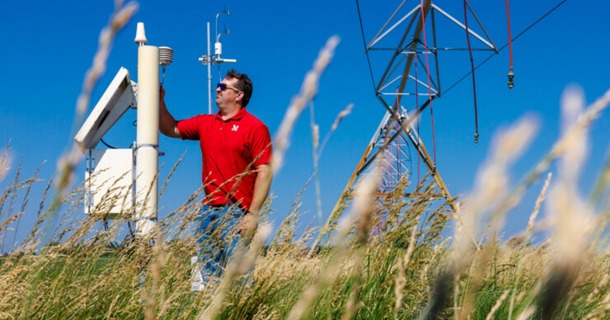UNL Projects Advance Study of Soil Moisture

Lincoln, Nebraska, July 2, 2024 — The University of Nebraska–Lincoln is now home to a neutron monitor, a sophisticated device that provides a crucial service by enabling correct real-time soil moisture and hydrology readings in Nebraska and nationwide. The monitor is only the third such device in the United States, and the only one located outside the East Coast.
The soil moisture corrections the device enables are needed because solar activity can disrupt the function of another device — cosmic ray neutron sensors. Across Nebraska, those upright metal devices stand in fields like little robots on sentry duty. The sensors capture and count neutrons reflecting off the Earth's surface after coming from outer space.
Real-time readings from the sensors are converted to soil moisture data and are important for making agricultural decisions and monitoring long-term climate change.
But when solar flares reach high levels, the resulting electromagnetic interference causes errors in the sensors’ soil moisture readings.
The powerful burst in solar activity during May 10-11 this year provided an example. The solar storm — the strongest since 2003 — not only affected soil moisture sensors; it also disrupted ag producers’ GPS access right as they were set to begin spring planting. Those producers depend on GPS technology for tasks such as equipment navigation, automated row shutoffs and variable rate input applications.
“Such large events create nice auroras that we can view from Nebraska, but they can also have huge consequences for our modern life,” said Trenton Franz, professor of hydrogeophysics and associate director of research for the School of Natural Resources at the University of Nebraska–Lincoln. Through Zoom or in-person sessions, Franz regularly trains scientists abroad in the use of cosmic ray neutron sensors and the overall science.
To correct the university’s soil moisture data, Franz and his university colleagues previously turned to help from a neutron monitor in Switzerland. The monitor measures the intensity of high-energy neutrons produced in the atmosphere by cosmic rays. The resulting information enables correction of sensors’ soil moisture readings.
Franz and his team realized that having such a device closer to home would ensure the best accuracy.
“When these solar flares happen, they may not hit Earth everywhere the same,” Franz said. “So, if we're using a detector in Switzerland to correct our data in the U.S., it may not be ideal.”
This spring, Franz and his colleagues installed a neutron monitor at the university’s Eastern Nebraska Research, Extension and Education Center near Mead. The device features an updated design that’s smaller, with efficient electronics geared for hydrology. Funding for the monitor was provided by grants totaling $686,873 from the National Science Foundation, Bureau of Reclamation and U.S. Geological Survey.
Data from the device “will be sent in real time and used by the space weather and hydrological communities,” said Franz, who also is a fellow with the Daugherty Water for Food Global Institute.
Such technology “is something the physics community has used for a long time to monitor cosmic rays,” Franz said. “And so we in the hydrology community want a more localized detector, to better correct our sensors.”
Darin Desilets, a New Mexico-based technologist who has collaborated with Franz on previous projects, designed the new monitor and oversaw the installation at ENREEC. Desilets is founder of Hydroinnova LLC, which specializes in such technology. Sophia Becker, a doctoral student working with Franz, is using the device as part of her dissertation in coordination with the U.S. Geological Survey.
In addition, Franz and his collaborators at other institutions are beginning a new interdisciplinary collaboration by which hydrologists and space weather scientists discuss joint goals to advance the study of cosmic radiation. The effort will kick off in October with a planning conference organized by Franz and partners with financial support from the National Science Foundation. The Nebraska Union will host the event.
“We have two communities that haven't worked closely together historically — the physics community working with space weather using the neutron monitors, and the hydrology and atmospheric science community working with low-energy neutron detectors for soil moisture,” Franz said. “The goal for the conference is to bring together these two groups of disciplines and think about what we might do with a future generation of combined low- and high-energy neutron detectors.”
It takes solar wind two to three days to reach Earth, and creating a more complete global monitoring network would help space weather scientists better predict which areas on the planet might be affected in regard to aviation, communications systems and other needs, Franz said.
The conference will aim to produce a white paper pointing to future scientific infrastructure needs and creating funding possibilities from interested federal agencies.
The disruptions from electromagnetic interference also have national security implications, Franz said. The most intense geomagnetic storm yet recorded was the Carrington Event of September 1859. The extraordinary event enabled auroras as far south as the Caribbean and triggered electrical surges that caused telegraph equipment to burst into flames.
A similar event in May 1967 disrupted operation of the Air Force’s early warning radars, leading to concern that the Soviet Union may have taken action toward war. The Air Force’s space weather forecasters calmed matters by explaining that the cause was actually a solar flare of exceptional strength.
Future solar events of that general scale are inevitable, Franz said, “so, in terms of national security, it's important to know in those situations if this is an attack or just a natural event that’s knocking out our system.”
